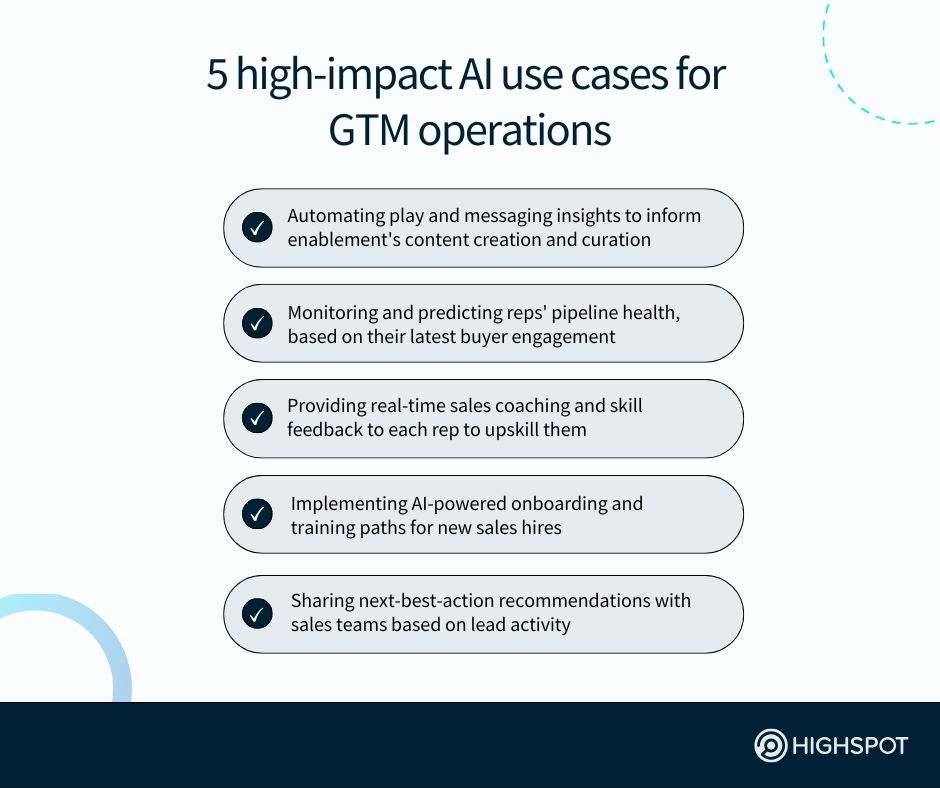Key Takeaways
- Go-to-market (GTM) operations leaders continue to explore the AI landscape to find the right tools for their sales, marketing, and enablement teams, but they struggle to identify the top ones among the ‘noise.’
- While many claim to have great GTM operations in place that work at the desired speed and consistency (98%, according to our GTM Performance Gap Report), business results from those efforts are lacking.
- Identifying gaps in your go-to-market strategy, filling them with AI-powered enablement solutions and processes, and adopting a continuous improvement mindset should be a top priority for your GTM ops today.
If you feel behind on embedding AI into your GTM operations, you’re not alone.
Many GTM ops leaders such as yourself recognise the value of artificial intelligence for go-to-market success. But between juggling existing systems, aligning teams, and chasing down insights, actually implementing the right AI tools across your sales, marketing, and enablement functions often takes a back seat.
Highspot’s GTM Performance Gap Report found 90% of go-to-market teams at large companies have implemented AI tools and capabilities in their functions or plan to do so soon. Yet seven in 10 (72%) of these functions still have low-to-moderate AI maturity.
This isn’t uncommon among enterprise GTM teams today—but time is ticking.
The longer enterprise GTM teams operate without these advanced and intelligent systems in place, the more they risk falling behind competitors who are already capitalising on AI to scale what works, gain insights to determine what is and isn’t working, and take actions to amplify best practices and fix problems.
Because here’s the reality: Incorporating cutting-edge AI in your business—particularly in your GTM organisation to drive process optimisation—is now table stakes.
To compete and win you need a unified, data-driven approach that can connect the dots across every customer-facing function (even your customer success department).
This isn’t about adding more tools to your already-expansive GTM tech stack.
Rather, it’s about finding proven AI-centric solutions that actually embed into how your teams work, making it easier to execute the best go-to-market strategy possible and produce strong (and increasingly better) business outcomes.
Why AI is a game-changer for GTM operations
What’s standing in the way of stronger GTM operations at your org is clear:
- Lack of clarity on where AI fits in your existing GTM workflows and motion at large
- Difficulty in driving full tool adoption across busy, distributed go-to-market teams
- Pressure to prove the impact and ROI of AI fast—without the runway to experiment
At the end of the day, though, it’s on GTM operations leaders like you to investigate and onboard the best AI tools that all your teams can use to elevate their performance.
That means working alongside your revenue operations team to find leading AI-powered GTM solutions that enable each customer-facing function to work with precision and insight.
More to the point, you need platforms that help your go-to-market team:
Streamline sales, marketing, and enablement data analysis
If your business is like most others, one of the biggest blockers to GTM performance is the sheer volume—and fragmentation—of data across sales, marketing, and enablement:
- Your sales team spends the vast majority of its time in your CRM system.
- Your marketing team is focused on integrated campaign performance metrics.
- Your enablement team tracks sales rep training and content engagement.
Despite all this activity in these critical functions, these efforts rarely connect.
That’s where a GTM enablement platform with native AI capabilities can help.
By analysing data from structured sources (think Salesforce records) and unstructured sources (like conversation intelligence from reps’ sales calls with potential customers), AI bridges silos and surfaces actionable insights that matter.
This can help tie marketing efforts to actual sales outcomes and enablement content directly to rep performance. You also get clear visibility into KPIs tied to the entire customer journey—without the spreadsheet gymnastics.
For sales operations teams tasked with strategic planning, in particular, this means being able to fix what’s broken and scale what works through sales performance tracking.
Meanwhile, AI can be the behind-the-scenes partner that ensures marketing, sales, and enablement remain aligned and focused on work that matters—not admin tasks.
Assist with both lead generation and pipeline management
Task automation isn’t the only core value prop of AI for your enterprise business.
The emerging technology provides data-driven insights that help with precision.
For you and your GTM operations team, that means supporting both the front end of the funnel (creating awareness, generating and qualifying leads, building strong relationships with prospects) and the forecasted deals that drive revenue.
Simply put, AI helps by analysing data to uncover which marketing efforts are generating more MQLs and which aren’t moving the needle. Similarly, it uncovers valuable insights that show the efficacy of enablement content in prospecting.
Consider Highspot:
- Our AI sales agents can help you identify buying signals across the customer journey and surface next-best action for your sales reps, like knowing the right time to connect with potential customers or which deal risks stalling.
- With a go-to-market enablement platform like ours that has native, purpose-built AI capabilities, your reps don’t end up spending hours each day in your CRM system combing over endless account-related notes.
- Instead, your sales professionals leverage data and AI from every interaction to distill complex datasets and guide more strategic decision-making.
This kind of real-time support ensures your sales team can close new business without chasing dead-ends. For sales operations, it’s a massive unlock, giving you the tools to optimise lead quality, pipeline health, and conversion velocity.
Drive growth by enhancing efficiency and decision-making
When it comes to growth, it’s no longer enough to just “do more.” You and other GTM operations leaders are under pressure to do what works—and prove it can scale.
That’s where AI can transform your sales team from guesswork-driven to insight-led.
By analysing data across content usage, rep activity, and customer engagement, the ideal AI solution delivers the kind of actionable insights that drive the right kind of behavioural changes across each team to boost go-to-market efficiency.
Using AI in sales and marketing helps you pinpoint which plays are winning, where messaging falls flat in deal discussions, and how to coach reps to higher performance.
And with an enablement platform at the centre of your GTM tech ecosystem, you don’t have to wait for end-of-quarter reporting to take action. You can fix what’s broken in real time and scale what works across teams to drive revenue growth.
Whether it’s improving sales operations workflows or modifying your marketing strategy, AI helps align your GTM around the same key metrics. That means less time spinning wheels, more time building momentum, and more new customers.

How your GTM ops team can leverage AI tools
“It’s clear that AI is already helping companies to cut costs and save time,” GTM operations expert Dean Guida recently wrote for Entrepreneur. “They’re often, though, applying AI to individual tasks across their business.”
However, Dean added it’s “only when these isolated efforts are aligned in support of a broader strategy that they can unlock a greater impact,” in terms of revenue generation.
Another way to put it? Your GTM operations team must know where and how to activate AI in your marketing, sales, and enablement efforts to truly take advantage of it for:
- Improving the customer experience: Whether it’s your customer success team cross-selling existing clients or your reps engaging interested buyers, AI can strengthen your relationship managers’ work.
- Analysing data across your business: This could mean account executives gleaning insights from Net Promoter Score surveys, marketing ops assessing campaign performance, or sales operations identifying sales process issues to rectify with reps—all with the help of advanced yet intuitive AI tools.
- Forecasting deals with revenue operations: Your GTM strategy’s purpose is to bolster your company’s bottom line. Working with your Chief Revenue Officer on data analysis with the aid of AI can help predict deal flow and, if needed, inform changes to go-to-market plans.
A few of the most popular use cases for AI in GTM operations today include:
| Use cases for AI in GTM operations | Key benefits for the AI use case |
|---|---|
| Accelerate the speed and effectiveness of various GTM activities. | – Quickly spot areas that are slowing down execution. – Align your AI investment with high-impact outcomes. – Free up resources tied to manual, repetitive tasks. – Streamline sales operations without adding headcount. – Improve how your reps spend time in your CRM system. – Connect fragmented workflows for all your GTM teams. – Speed up cycle times with automation in the right places. – Ensure AI supports—not disrupts—your customer journey. – Set your GTM teams up to win faster and more consistently. |
| Drive greater collaboration among sales, marketing, and enablement. | – Avoid confusion as your GTM teams work asynchronously. – Clarify ownership/key responsibilities so teams act with intent. – Help sales operations and enablement move in lockstep. – Ensure marketing efforts are aligned to AI-driven actions. – Reduce friction between content, training, and pipeline execution. – Empower your sales reps with tools that actually get used. – Drive accountability by tying go-to-market actions to outcomes. – Support more strategic planning by giving teams clear mandates. – Create repeatable workflows so they can scale what works. |
| Leverage AI for continuous improvement across your GTM teams. | – Start small with AI utilisation to ensure intentionality. – Learn where AI technology makes the biggest difference. – Gather feedback from your sales team and iterate fast. – Capture measurable outcomes tied to key metrics. – Build credibility with executives by showing early wins. – Get closer to your buyers by analysing data that matters. – Refine your customer journey based on real-time insight. – Fix what’s broken within GTM without boiling the ocean. – Set a foundation for long-term, scalable AI success. |
There are many other areas where AI can and should be deployed. That said, beginning with these use cases is often a good starting point for any GTM operations team, regardless of industry, business model, or company size.
If you ever wonder why go-to-market strategies fail at some enterprises today, it’s often due to unpreparedness with introducing AI into existing GTM operations.
AI FAQs from go-to-market operations, answered
Like so many other B2B go-to-market leaders today, you’ve likely got some questions around the use of artificial intelligence in sales. And we’ve got answers. Here are insights that can help you start (or kickstart) your AI strategy.
How does AI enhance our team’s GTM strategy execution?
Artificial intelligence helps your revenue team stay laser-focused on what actually works. Instead of reacting after the fact, you can proactively execute based on real-time insights and make the necessary go-to-market changes and upgrades.
When every function has access to the same data and AI-generated guidance, your GTM strategy isn’t just a plan on paper—it’s a set of coordinated, measurable actions your marketing, sales, and enablement teams can rally around.
Which GTM workflows benefit most from AI automation?
The onboarding of AI is a game-changer for all those repetitive, decision-heavy tasks that eat up your GTM team’s time. Think content personalisation, lead scoring, rep coaching, and even tracking adoption of strategic initiatives.
When you start by integrating AI into day-to-day GTM operations in these areas, you boost both speed and impact—without needing to overhaul your entire sales process overnight.
Does AI boost operational efficiency across go-to-market?
Absolutely. The most innovative AI tools take what used to be hours of manual work—analysing data, building dashboards, finding top-performing assets—and automates it to ensure operational excellence across GTM.
That means GTM ops can spend more time making decisions, not collecting data. It also helps each function work smarter, so you’re not just running faster—you’re collectively moving in the right direction and in sync at all times.
How can we best implement AI in go-to-market operations?
Start small and focused. Choose a problem area—maybe inconsistent rep behaviour or unclear campaign ROI—and test how AI can help. Let GTM operations lead the way, then bring in marketing and enablement to scale the solution.
Keep it tied to outcomes, not hype. When you roll out AI for sales, marketing, and enablement, do so with purpose and clear ownership (meaning everyone has distinct, key responsibilities), adoption is easier and value shows up faster.




